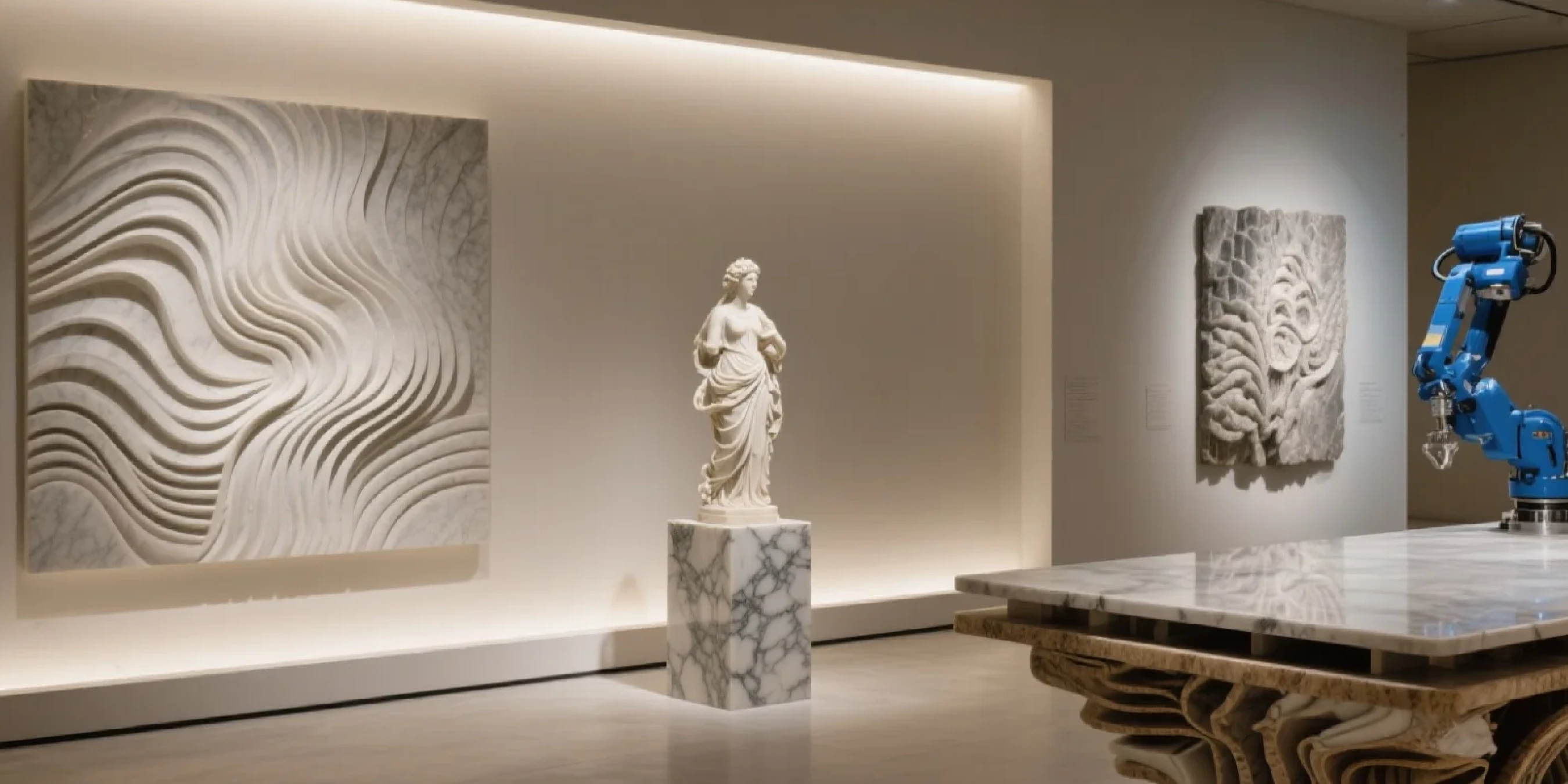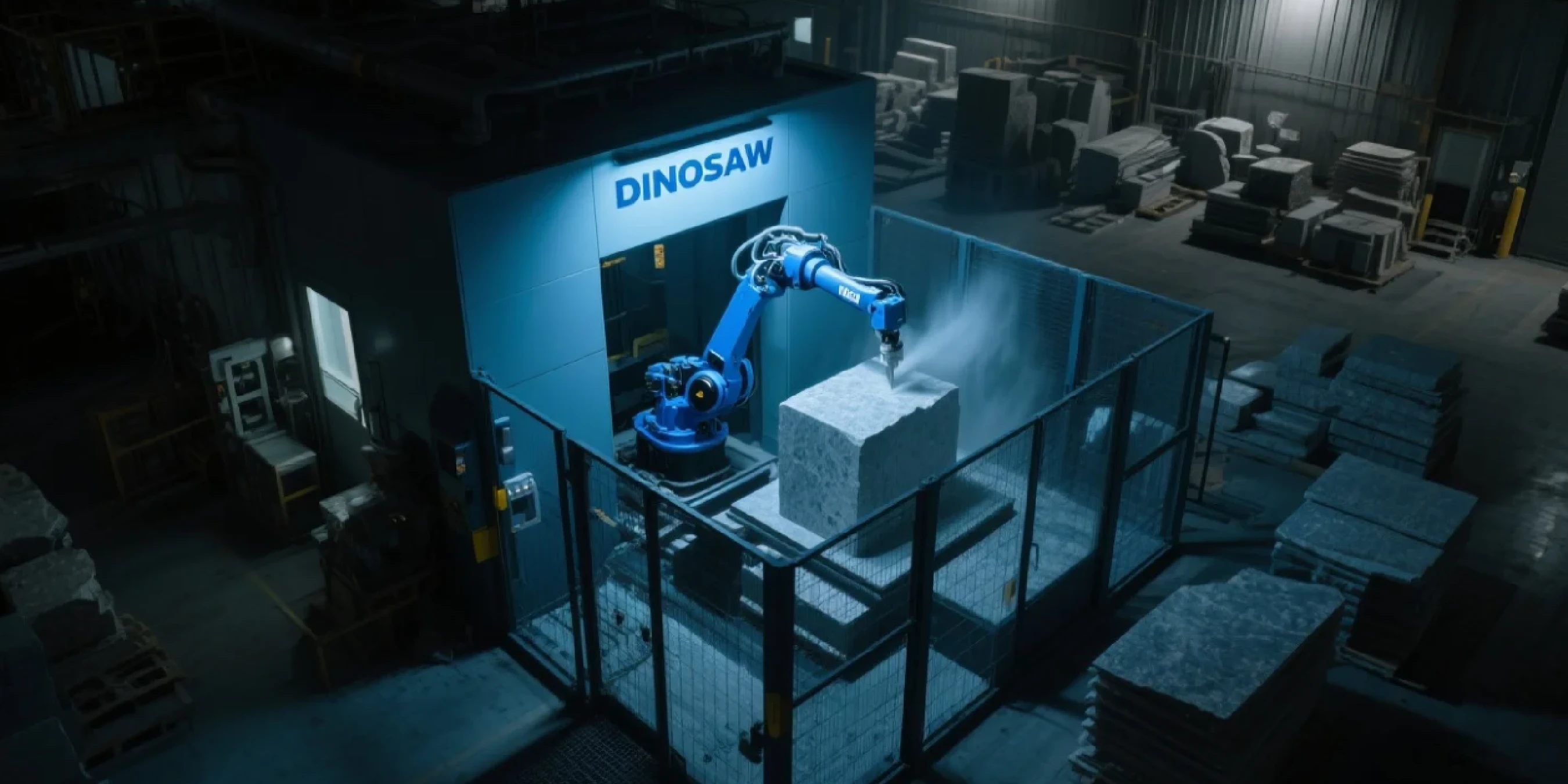Hi, this is Lizzy from Dinosaw ( Not a Robot ). Which Machine ( model ) do you want? Please WhatsApp us now
Discover how robotic 3D carving and polishing are revolutionizing stone fabrication. Our 2025 guide covers applications, implementation, ROI, and the future of automated craftsmanship.
Real talk from real fabrication shops. No hype, just what's actually happening with automation right now.
I just got back from visiting a dozen stone shops across the country. Here's what's really happening with robotic automation.
Most people think robots are just for moving heavy slabs around. Wrong. Today's robots carve intricate sculptures, polish complex curves, and do detail work that would make a master craftsman jealous. The question isn't whether this technology works-it's whether your business is ready for it.

The Labor Crisis Nobody Talks About
Bottom line: We're running out of skilled stone workers. Fast. A master carver who can handle complex architectural elements? Good luck finding one for under $80K a year.
The Perfect Storm Hitting Fabricators
Every shop owner I talked to mentioned the same three problems. Experienced craftsmen are retiring faster than we can train new ones. Young workers don't want to get into stone work-it's dusty, physical, and honestly pretty dangerous. Meanwhile, clients keep asking for more complex designs and tighter tolerances.
- Skilled workers aged 50+ are 70% of the workforce in many shops
- Training a new stone carver takes 2-3 years minimum
- Labor costs for finishing work have doubled in five years
High-End Market Explosion
At the same time, the luxury construction market is booming. USGS data shows dimension stone consumption hitting record highs, driven by custom residential and commercial projects.
These aren't your standard countertop jobs. We're talking custom sculptures, intricate architectural details, and complex curved surfaces that require genuine artistry. This is exactly where robotic automation shines-scaling up artisan-level work without the artisan bottleneck.
Real Applications: Beyond the Marketing Fluff
Let's be clear about something first. Not all robots are created equal. Your basic 5-axis CNC and a 6-axis robotic arm are completely different animals.
Here's the real difference:
5-axis CNC: Fast, precise cutting. Great for slabs and simple profiles.
6-axis robot: Unlimited flexibility. Can reach any angle, switch tools on the fly, handle complex 3D work that would be impossible on traditional machines.
What These Machines Actually Do Well
3D Carving & Sculpting
Complex sculptures, architectural details, custom reliefs. Robots can carve undercuts and intricate geometries that traditional machines simply can't reach.
Precision Polishing
Consistent pressure control across complex surfaces. Force-sensing technology ensures perfect finishes on curved edges and sculptural pieces.
I watched a Dinosaw robotic system switch from carving a marble fireplace surround in the morning to polishing granite countertop edges in the afternoon. Same robot, different tools. That kind of versatility changes your entire production workflow. For reference on traditional machinery capabilities, check out this comprehensive guide to stone CNC machines.

Your Implementation Roadmap
Too many shop owners get excited and buy first, plan later. That's expensive. Here's how to do it right.
Step 1: Figure Out Your Biggest Pain Point
What's killing your profitability? Is it the time spent hand-polishing complex edges? Your inability to bid on sculptural work? Get specific about the problem you're solving.
Track where your skilled labor spends the most time
- Identify which jobs you turn down due to complexity
- Calculate the real cost of rework and material waste
Step 2: Choose the Right Robot (Not the Shiniest One)
Bigger isn't always better. More expensive isn't always smarter. Focus on these specs:
- Rigidity: Can it handle cutting forces without deflection?
- Repeatability: ±0.1mm minimum for quality work
- Environmental protection: IP67 rating for stone shop conditions
Step 3: Master the Software (This Is Where Most Fail)
The robot is only as smart as the software driving it. Modern CAD/CAM platforms like Alphacam or PowerMill make programming surprisingly intuitive, but there's still a learning curve.
Offline programming is your friend-simulate everything on the computer before the robot moves an inch.
Step 4: Safety First (Non-Negotiable)
Robotic systems require proper safety implementation. ANSI/RIA R15.06 standards aren't suggestions-they're requirements.
- Physical guarding with safety-rated gates
- Light curtains or area scanners
- Emergency stop systems within easy reach
Step 5: Train Your Best People
Your experienced CNC operators are perfect candidates for robot programming. They already understand toolpaths and machining principles-this is just the next evolution.
Expect 3-5 days of intensive training to get them comfortable with the system.
Need help evaluating your shop's automation potential?Chat with our automation specialists for a free assessment
Dinosaw in Action: Real Results from Real Shops
Case Study: Luxury Hotel Sculpture Project
A high-end hotel needed 12 identical marble sculptures for their lobby-each piece 8 feet tall with incredibly intricate detail work. Traditional carving would have taken months and still couldn't guarantee consistency between pieces.
Using a Dinosaw robotic carving system, the fabricator went from 3D model to finished sculpture in 6 weeks per piece, with precision tolerance under 0.05mm. The client was so impressed they ordered 8 additional pieces for other properties.
"If we'd tried this project manually, the material waste alone would have bankrupted us. The robot doesn't just work faster-it works smarter." - Project Manager
Equipment Spotlight: Proven Solutions
Dinosaw 3D Carving System
Built specifically for stone machining with high-rigidity arms and powerful spindles.
Handles everything from soft marble to hard granite with consistent precision.
View technical specs →
Dinosaw Polishing Robot
Force-controlled polishing system that adapts pressure automatically. Achieves mirror finishes on complex curved surfaces that would be impossible by hand.
See polishing results →
What's Coming Next: Future Trends Worth Watching
Robotic stone processing is evolving fast. Here's what I'm seeing on the horizon:
AI-Powered Quality Control
Machine vision systems that scan slabs before processing, automatically identify flaws, and adjust toolpaths to optimize material yield. The International Federation of Robotics reports that AI integration is the fastest-growing segment in industrial automation.
Mass Customization Made Easy
Robots make producing unique, one-off pieces as efficient as batch production. Reprogramming takes minutes, not hours. This opens up entirely new market segments for fabricators willing to embrace the technology.
Human-Robot Collaboration
Collaborative robots (cobots) that work safely alongside humans without extensive safety barriers. The robot handles the heavy grinding and rough shaping while the craftsman focuses on artistic details and final touches.
Ready to Make the Move?
Robotic automation isn't coming to stone fabrication-it's already here. The shops that adopt it now will define the industry's future. The ones that wait? They'll be competing on price while everyone else competes on capability.
Transform Your Fabrication Process Today
Don't let competitors get ahead while you're still thinking about it.
Start Your Automation Journey
Frequently Asked Questions
What's the real difference between a 5-axis CNC and a 6-axis robot for stone work?
Think of it this way: a 5-axis CNC is like a precision saw-incredible for cutting and basic shaping, but limited to relatively simple geometries. A 6-axis robot is like giving a master craftsman unlimited reach and perfect consistency. If you're doing mostly countertops and simple profiles, stick with CNC. If you want to handle complex sculptures and architectural details, robots are the way to go.
What does a robotic system actually cost?
Anywhere from $80K to $300K+, depending on payload, precision requirements, and tooling. But don't just look at upfront costs-calculate payback period. Most shops see ROI in 18-36 months through increased productivity, reduced labor costs, and the ability to take on higher-margin complex work.
How hard is it to learn robot programming?
Way easier than it used to be. Modern software uses graphical interfaces-you program toolpaths visually on your computer screen. If your operators can handle CNC programming, they can learn robot programming. Expect 3-5 days of training to get competent, a few weeks to get really good at it.
Can robots handle different stone types?
Absolutely. From soft marble to hard quartzite, it's all about setting the right parameters and choosing appropriate tooling. The software stores material-specific settings, so switching between stone types is just a matter of selecting the right program.
What kind of ROI should I expect?
It depends on your application, but most shops see 2-3x productivity gains from 24/7 operation capability. Add in labor cost savings, reduced material waste, and the ability to bid on high-margin complex work, and 18-36 month payback is typical. Custom architectural work and sculptural pieces pay back even faster.
What about safety requirements?
Safety is critical and non-negotiable. You'll need proper guarding, safety-rated gates, light curtains or area scanners, and emergency stops. Sounds complicated, but any reputable supplier will design the complete safety system. Done right, robotic cells are actually safer than manual operations.
Can one robot do multiple operations?
This is where robots really shine. With automatic tool changers, the same robot can rough-carve, finish-carve, and polish-all in one setup. It's like having three specialized machines in the footprint of one, with perfect handoff between operations.
























 English
English 中文
中文 Italian
Italian Türkçe
Türkçe Português
Português

